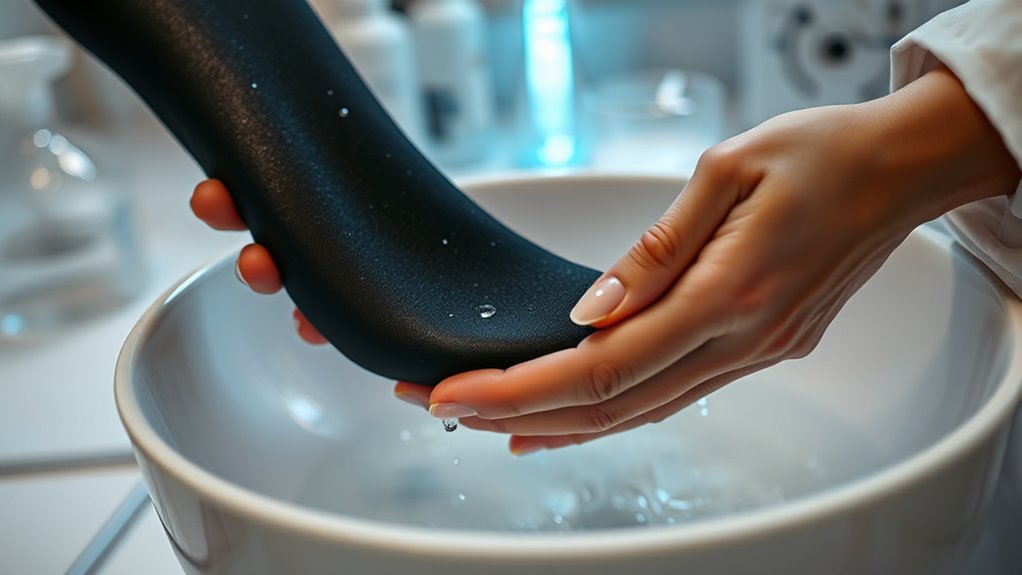To make tights last longer, handle them gently and follow proper care routines. Wash with a gentle detergent in cold water, preferably on a delicate cycle or handwash, and turn them inside out to reduce surface damage. Avoid heat drying by air drying flat away from sunlight or heat sources. Store by folding and rotating them regularly. Small tears can be repaired with patches or glue. Keep learning how small adjustments can extend your tights’ lifespan.
Key Takeaways
- Wash tights inside out on a delicate cycle with cold water and mild detergent to preserve fiber strength and color.
- Hand wash or spot clean stains to minimize unnecessary wear and extend the time between washes.
- Air dry tights flat away from heat sources and direct sunlight to prevent fiber damage and fading.
- Store tights folded in breathable containers, and avoid hanging to prevent stretching of fibers.
- Perform small repairs promptly using fine needles, clear nail polish, or fabric glue to maintain elasticity and prolong lifespan.
Understanding the Materials and Construction of Tights
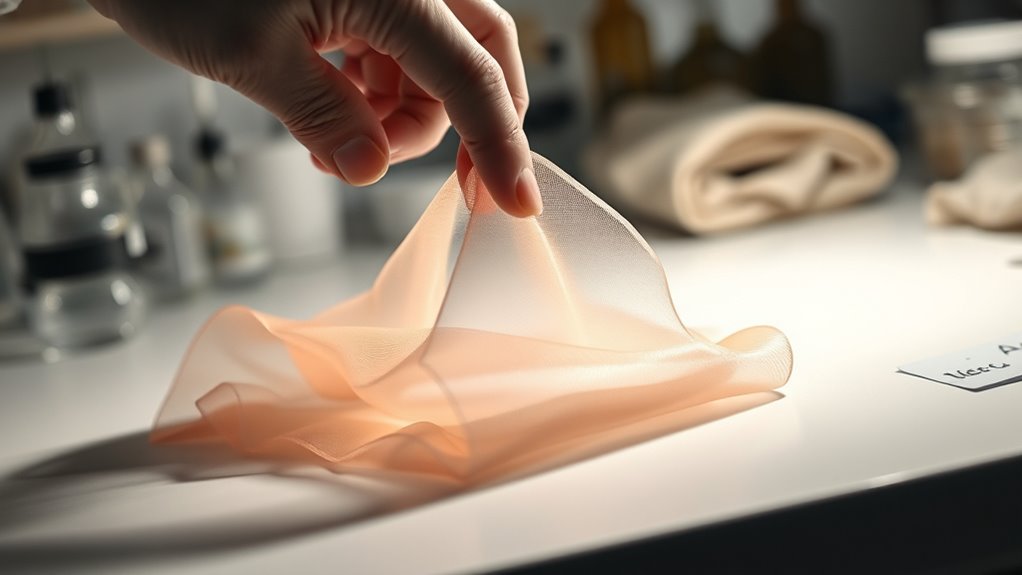
Understanding what tights are made of and how they’re constructed is key to choosing the right pair and making them last. The fiber composition determines their durability, stretch, and comfort. Common fibers include nylon, spandex, and polyester, each offering different qualities. Nylon provides strength and elasticity, while spandex adds stretch and shape retention. The fabric weave also plays an essential role; a tightly woven fabric is more resistant to snags and tears, extending the lifespan of your tights. Look for a dense, uniform weave to guarantee durability. By understanding the fiber composition and fabric weave, you can select tights that not only fit well and feel comfortable but also stand up to regular wear and washing, saving you money in the long run.
The Importance of Proper Washing Techniques

Using a gentle detergent and cold water keeps your tights looking their best longer. Harsh soaps and hot water can weaken fibers and cause fading. Stick to these simple techniques to extend the life of your favorite pair. Incorporating proper washing techniques ensures the longevity of delicate fabrics.
Gentle Detergent Choices
Choosing the right detergent is essential for keeping your tights in top shape. Opt for gentle, mild detergents formulated for delicate fabric blends to preserve elasticity and dye stability. Harsh cleaners can weaken fibers and cause colors to fade faster. Look for detergents labeled for delicate or sensitive skin, as they tend to be free of dyes and fragrances that can harm tights. Selecting detergents that are compatible with fabric care guidelines ensures optimal preservation of your tights over time.
Cold Water Wash
Did you know that washing your tights in cold water can substantially extend their lifespan? Cold water helps maintain the pH balance of your tights’ fibers, preventing damage caused by harsh temperatures. This gentle approach reduces fiber stress and keeps colors vibrant. Avoid using fabric softeners, as they can leave residues that weaken delicate fabrics over time. Instead, opt for a mild detergent formulated for cold washes, which cleans effectively without disrupting fiber integrity or pH levels. Proper washing techniques like this prevent stretching, shrinking, and pilling, ensuring your tights stay in top condition longer. By prioritizing cold water and mindful detergent choices, you give your tights the best care, preserving their fit, elasticity, and appearance for many wears.
Choosing the Right Detergent for Delicate Fabrics
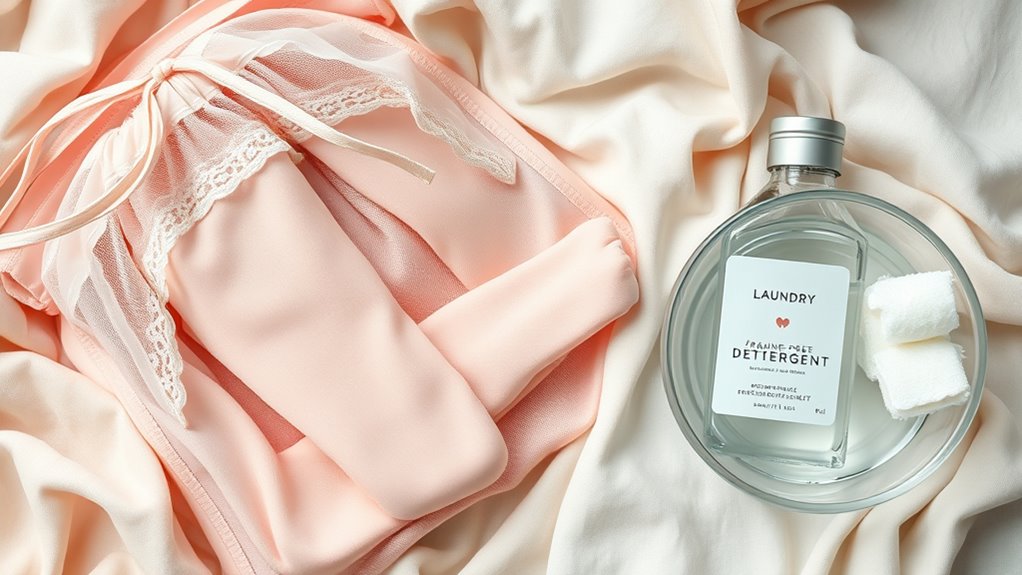
When caring for delicate fabrics like tights, selecting the right detergent is essential to prevent damage and maintain their elasticity. Look for detergents formulated specifically for delicate fiber blends, as these are gentler on sensitive materials. Check the detergent ingredients; avoid harsh chemicals like bleach or strong enzymes that can weaken fibers. Instead, opt for mild, plant-based or hypoallergenic options that clean effectively without stripping away elasticity. A gentle detergent preserves the fabric’s integrity and prolongs wear. Additionally, choose a detergent with a neutral pH to reduce fiber stress. Using a detergent with high color accuracy ensures that the tights’ true color is maintained over time, preventing fading and discoloration. By selecting a careful blend of gentle detergent ingredients suited for delicate fiber blends, you ensure your tights stay smooth, stretchy, and looking their best over time.
Optimal Washing Settings and Handwashing Tips
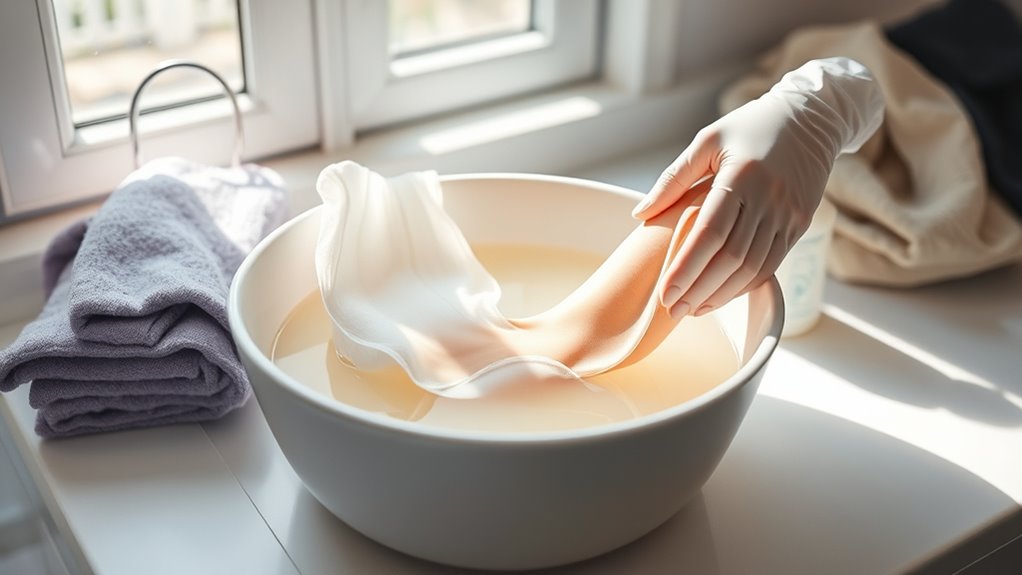
To keep your tights in top condition, it’s important to use the correct washing settings and consider handwashing for added care. Set your machine to a delicate cycle with cold water to preserve color fastness and prevent fading. Use a gentle, mild detergent to protect the fabric’s integrity and avoid harsh chemicals that can weaken elastic fibers. When handwashing, gently soak tights in cool water with a small amount of detergent, then softly agitate to clean without stretching or tugging. Rinse thoroughly to remove residue. Properly washing at low temperatures and avoiding excessive agitation helps maintain elastic elasticity and vibrant colors, extending your tights’ lifespan. Understanding fabric care and these simple steps ensure your tights stay comfortable, vibrant, and in shape longer.
Drying Do’s and Don’ts for Tights

When drying your tights, avoid using heat dryers, as high temperatures can harm the fabric. Instead, lay them flat to dry, preventing stretching and wrinkling. Be gentle and keep them smooth to ensure they stay in great shape for longer. Incorporating a gentle exfoliation routine can also help maintain the fabric’s integrity and appearance over time.
Skip Heat Drying
Avoid using heat to dry your tights, as it can weaken the fibers and cause damage. Heat drying accelerates fabric shrinkage, which compromises the fit and elasticity of your tights. The high temperatures break down the fibers, making them more prone to tears and thinning over time. Instead, opt for air drying in a well-ventilated area. Gently squeeze out excess water without twisting, and lay your tights flat or hang them to dry naturally. This method preserves the fabric’s integrity, maintains elasticity, and extends their lifespan. Skipping heat drying also prevents unnecessary fabric shrinkage, helping your tights stay snug and comfortable longer. Remember, patience with air drying pays off in the durability and appearance of your favorite hosiery. Proper drying techniques also help maintain the fabric’s elasticity, ensuring your tights retain their original fit and comfort for a longer period.
Use Flat Lay Technique
Using the flat lay technique is one of the best ways to dry your tights without risking damage. Lay them flat on a clean, dry surface like a towel or drying rack, avoiding hanging which can stretch the fabric. This method helps maintain the fabric’s durability by preventing unnecessary tension that could cause tears or thinning over time. It also promotes even drying, reducing the risk of color fading or uneven spots. Make sure to smooth out wrinkles gently, and keep the tights away from direct sunlight, which can accelerate color loss. Additionally, the flat lay method is especially effective for electric bikes, as it preserves the integrity of delicate components during maintenance or storage. By drying your tights flat, you preserve both their vibrant color and structural integrity, extending their lifespan. This simple step ensures your tights stay comfortable, colorful, and durable for many wears.
Avoid Wrinkling and Stretching
To prevent wrinkling and stretching, handle your tights gently during the drying process. Avoid wringing or twisting fabric blends, as this can distort their shape and damage dye fastness. Instead, lay them flat on a clean towel or drying rack, smoothing out wrinkles with your hands. High-stretch fabric blends are especially prone to stretching if pulled or hung unevenly, so keep tension minimal. Resist the urge to hang tights using clips, which can create unwanted creases or stretch marks. Proper drying helps maintain dye fastness, ensuring colors stay vibrant and don’t fade prematurely. Air drying at room temperature is best; avoid heat sources like radiators or direct sunlight that can weaken fibers and cause fading. Gentle handling preserves the fit, color, and longevity of your tights. Additionally, understanding the impact of fabric composition can guide you in selecting the best drying methods for different tights materials.
Storage Solutions to Prevent Damage

Proper storage is essential to keep your tights in good condition and prevent damage over time. Start by organizing your tights through color coordination, which makes it easier to find the right pair and reduces unnecessary handling. Fold each pair neatly instead of hanging them, as hanging can stretch the fibers. For seasonal storage, consider keeping off-season tights in a separate, labeled container to prevent clutter and accidental damage. Use breathable storage options like fabric drawers or paper bags to avoid moisture buildup. Avoid overcrowding your storage space, as tight packing can cause snags or tears. Regularly inspect your stored tights for signs of damage or color fading, and rotate your collection to ensure even wear. Additionally, mindful organization can help maintain the condition of your tights and extend their lifespan. Proper storage extends the life of your tights considerably.
Repairing Small Tears and Snags Effectively
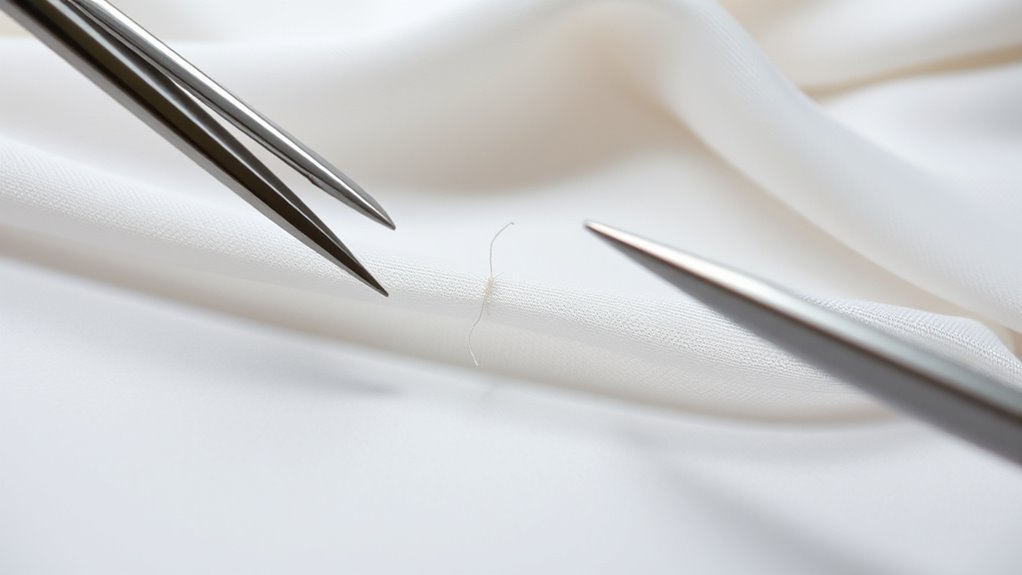
When you notice small tears or snags in your tights, addressing them promptly can prevent further damage. Start by carefully turning the tights inside out and inspecting the area. Use a fine needle and clear nail polish or fabric glue for snag repair, securing the fibers and preventing the tear from worsening. For small tears, reinforce the fabric with a tiny patch of matching fabric or a special fabric reinforcement tape, carefully sewing or sticking it over the damaged area. Be gentle to avoid pulling or stretching the fibers further. Always handle tights delicately during repair to maintain their elasticity. Proper snag repair and fabric reinforcement can extend the life of your tights, keeping them looking good and functional longer.
Tips for Extending the Wear Between Washes
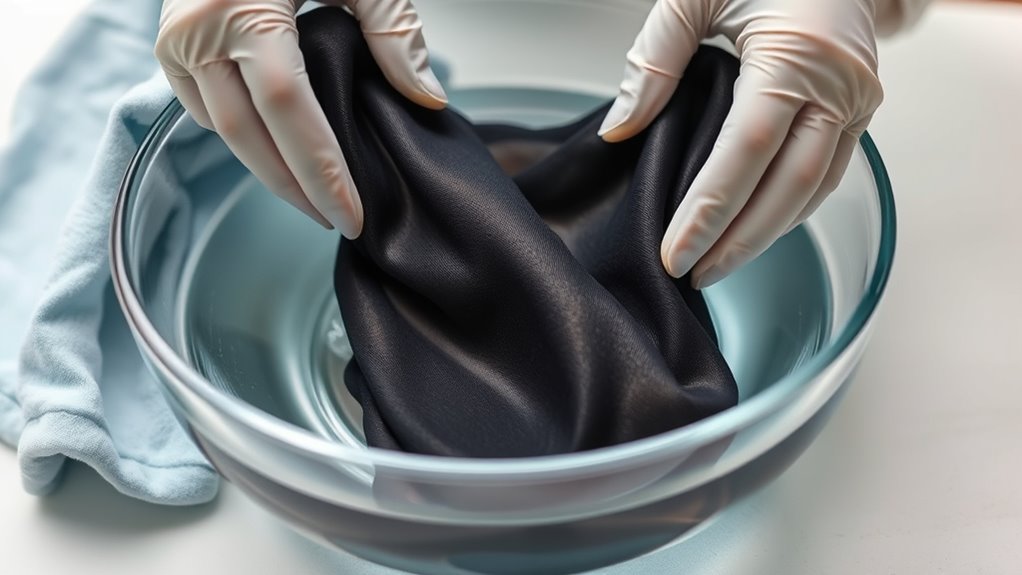
Since frequent washing can wear out tights quickly, finding ways to extend their wear between washes is essential. To do this, focus on managing fiber blends and dye fastness. Spot clean stains with a damp cloth instead of washing the entire pair. Rotate tights with different fiber compositions to reduce stress on any one blend. Use a gentle, cold wash cycle when necessary, and avoid harsh detergents that can break down fibers. Proper storage, like folding instead of hanging, prevents stretching. Consider applying a fabric refresher spray to keep them fresh longer. Additionally, implementing automation in business can streamline laundry routines and reduce handling time. Here’s a quick guide:
| Tip | Why it Helps | Best Practice |
|---|---|---|
| Spot cleaning | Preserves fiber integrity | Use damp cloth |
| Rotate fiber blends | Minimizes strain on fibers | Mix tights with different fibers |
| Cold, gentle washing | Maintains dye fastness and fibers | Use mild detergent |
| Proper storage | Prevents stretching and damage | Fold, avoid hanging |
| Fabric refresher spray | Keeps tights smelling fresh | Light spritz after wear |
When to Replace Tights and How to Maintain Them Longer
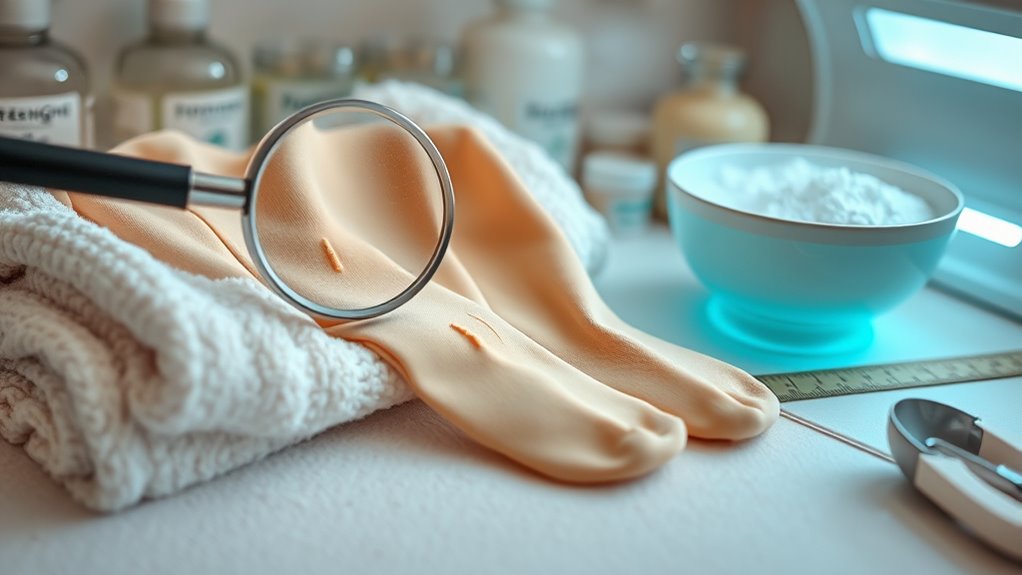
Knowing how to extend the life of your tights involves more than just careful washing. Regularly check for signs of wear, like runs or thinning fabric, to determine when it’s time to replace them. Staying on top of fashion trends helps you choose tights with durable materials that last longer, reducing waste. Maintaining your tights properly not only saves money but also lessens their environmental impact. Rotate between different pairs to avoid overstressing one set. When you notice significant damage, replace your tights promptly to prevent further tearing. By caring for your tights carefully and being mindful of their condition, you can enjoy current fashion trends longer while making eco-conscious choices that benefit the environment.
Frequently Asked Questions
How Can I Identify the Best Tights for Durability?
To find the most durable tights, you should examine the fabric weave and fiber composition. Look for tights with a tight, dense weave, which offers better strength and resistance to snags. Check the fiber composition; blends with nylon or elastane tend to be more resilient and stretchable. Avoid tights with thin or loose weaves, and opt for those made from high-quality fibers for longer-lasting wear.
Are There Eco-Friendly Laundry Options for Tights?
You can find eco-friendly laundry options for tights by choosing biodegradable detergents, which break down naturally and decrease environmental impact. Look for detergents made from plant-based fibers and natural ingredients to keep your tights clean without harmful chemicals. Using cold water and gentle cycles also helps preserve their integrity. These eco-conscious choices guarantee your tights stay durable while supporting sustainability efforts.
Can I Safely Bleach or Stain-Treat Tights?
You shouldn’t bleach or stain-treat tights, as bleach risks damaging delicate fibers and causing discoloration. Instead, focus on gentle stain treatment with mild soap or specialized stain removers designed for delicate fabrics. Always test any stain treatment on a small, hidden area first. This approach helps preserve your tights’ elasticity and color, ensuring they last longer without risking damage from harsh chemicals.
How Do Temperature Fluctuations Affect Tights Longevity?
Temperature fluctuations can negatively impact your tights’ longevity by affecting fabric elasticity and causing fiber degradation. When you expose tights to sudden changes in temperature, the fibers weaken and lose their stretch, making them prone to tears and runs. To preserve their condition, avoid extreme or rapid temperature shifts during washing and drying. Keeping your tights in a stable, moderate environment helps maintain their elasticity and extends their lifespan.
What Signs Indicate It’S Time to Retire My Tights?
Think of your tights as a delicate dance partner. When you notice fabric pilling or color fading, it’s a sign they’re tired and should retire. These signs show that the fibers are breaking down and losing their strength. If your tights no longer cling smoothly or the colors look dull, it’s time to say goodbye. Caring for them prevents further damage, but knowing when to retire keeps your wardrobe fresh and vibrant.
Conclusion
By giving your tights gentle care and mindful attention, you create a quiet harmony that keeps them gracefully fitting your life. With a little extra patience and understanding, you’ll find that their delicate beauty endures, whispering stories of careful stewardship. In nurturing your tights, you nurture a subtle elegance that lasts, reminding you that true quality often blooms in the smallest acts of kindness. Embrace this mindful approach, and your favorites will quietly continue to serve you well.
